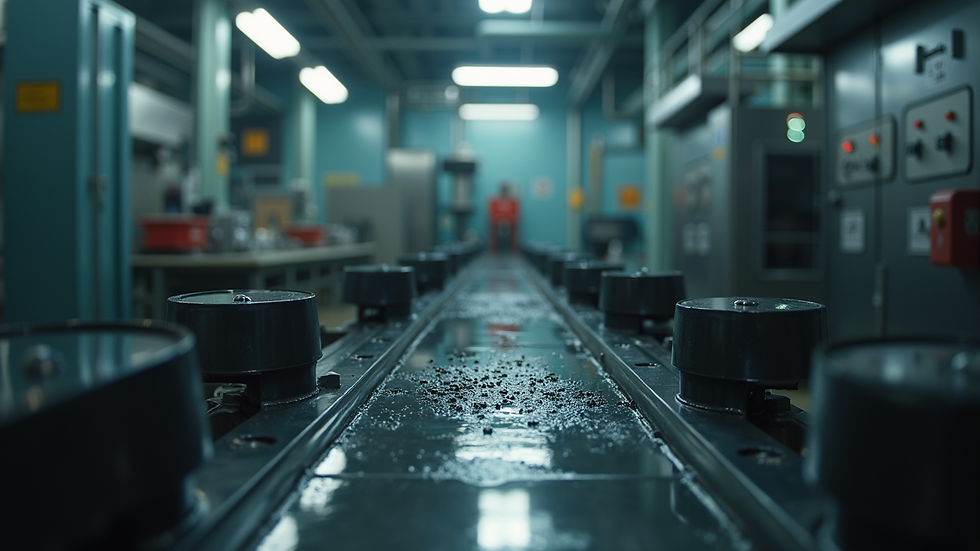How Calcium Grease Is Manufactured
- Lubechem consultant
- Aug 17
- 3 min read
Calcium grease is a widely used lubricant known for its excellent water resistance, corrosion protection, and mechanical stability. It is commonly applied in automotive, industrial, and marine environments to ensure smooth operation of machinery and reduce wear and tear. Understanding how calcium grease is manufactured can provide valuable insights into its properties and applications.
What Is Calcium Grease?
Calcium grease is a type of lubricating grease that uses calcium soap as its thickening agent. The base oil, usually mineral oil, is combined with calcium-based soap to create a semi-solid lubricant. This grease is favored for its ability to resist water washout and protect metal surfaces from rust and corrosion.
Some key characteristics of calcium grease include:
Water resistance: It can withstand exposure to moisture without losing its lubricating properties.
Good adhesion: It sticks well to metal surfaces, reducing the need for frequent reapplication.
Corrosion protection: It forms a protective barrier against rust.
Moderate temperature tolerance: Typically effective up to 120°C (248°F).
These properties make calcium grease ideal for applications such as wheel bearings, chassis lubrication, and general-purpose industrial use.

The Role of Calcium Soap in Calcium Grease
Calcium soap is the thickener that gives calcium grease its unique consistency and performance. It is produced by reacting calcium hydroxide (lime) with fatty acids derived from natural oils or fats. This reaction forms calcium salts of fatty acids, which act as the soap component in the grease.
The calcium soap molecules create a three-dimensional network that traps the base oil, resulting in a stable, semi-solid lubricant. The structure of calcium soap contributes to the grease’s water resistance and mechanical stability.
Some common sources of fatty acids used in calcium soap production include:
Tallow (animal fat)
Vegetable oils (such as palm or coconut oil)
Oleic acid
The choice of fatty acid affects the grease’s hardness, melting point, and overall performance.

How to manufacture calcium grease?
Manufacturing calcium grease involves several key steps that ensure the final product meets quality and performance standards. The process typically includes:
Preparation of raw materials: The base oil, calcium hydroxide, and fatty acids are sourced and prepared. The base oil is usually refined mineral oil with specific viscosity requirements.
Saponification: Calcium hydroxide is reacted with fatty acids in a controlled environment to produce calcium soap. This step requires precise temperature and mixing control to ensure complete reaction.
Grease formation: The calcium soap is mixed with the base oil under heat and agitation. This creates the thickened grease structure. The mixture is stirred until the desired consistency is achieved.
Additive incorporation: Performance-enhancing additives such as antioxidants, corrosion inhibitors, and extreme pressure agents may be added to improve the grease’s properties.
Cooling and packaging: The grease is cooled to room temperature and then packaged into containers for distribution.
Each step requires careful monitoring to maintain product consistency and quality. The calcium grease manufacturing process is optimized to produce grease with excellent water resistance and mechanical stability.

Quality Control in Calcium Grease Production
Ensuring the quality of calcium grease is critical for its performance in demanding applications. Manufacturers implement rigorous quality control measures throughout the production process, including:
Viscosity testing: To confirm the base oil meets specifications.
Penetration testing: Measures the grease’s hardness and consistency.
Dropping point test: Determines the temperature at which the grease melts.
Water resistance test: Assesses the grease’s ability to resist washout.
Corrosion protection test: Evaluates the grease’s effectiveness in preventing rust.
These tests help maintain product reliability and ensure the grease performs as expected in the field.
Applications and Benefits of Calcium Grease
Calcium grease is widely used across various industries due to its unique properties. Some common applications include:
Automotive: Lubricating wheel bearings, chassis components, and universal joints.
Marine: Protecting equipment exposed to water and salt spray.
Industrial machinery: Lubricating bearings, gears, and other moving parts.
Agricultural equipment: Providing protection in harsh outdoor environments.
The benefits of using calcium grease include:
Extended equipment life: Reduces wear and corrosion.
Reduced maintenance: Water resistance means less frequent reapplication.
Cost-effectiveness: Generally affordable compared to specialty greases.
Environmental resistance: Performs well in wet and humid conditions.
Understanding the manufacturing process helps users appreciate why calcium grease is a reliable choice for many lubrication needs.
By exploring the detailed steps and components involved in calcium grease production, you gain a clearer picture of what makes this lubricant effective. Whether you are selecting grease for industrial use or simply curious about manufacturing processes, knowing how calcium grease is made can guide better decisions and applications.


Comments